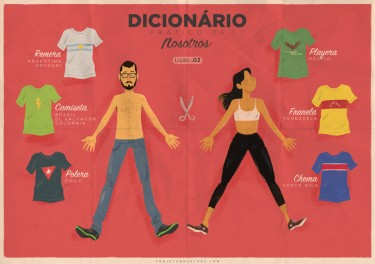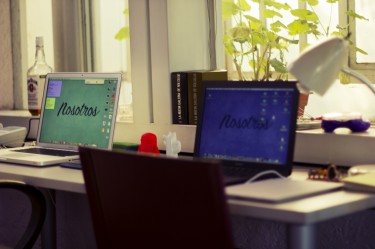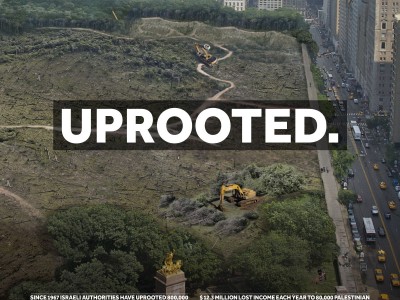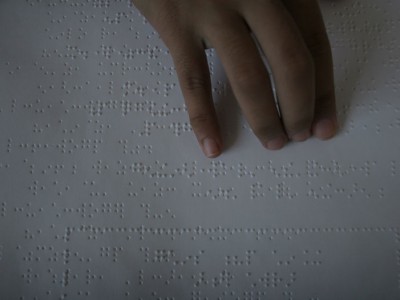Following the comic book series posted on Global Voices Online, we now focus on one of its featured characters – Projeto Nosotros [“Us Project”], an initiative by two young Brazilian communicators who made their own way to track down creative talents and skilled artists while exploring the rich cultural matter of modern Latin America, going beyond stereotypes. Traveling around the region, they meet and interview young producers of modern culture, sharing their work online and through social media.
Rising Voices (RV): What made you both interested in these multiple identites – that which make us “nosotros” [“us” in Spanish]?
We began by wanting to live abroad for the first time, but we didn’t know where to go. We looked for places and educational courses in the US and Europe, as do many Brazilians. But then we realised that we really know very little about our own region, and tend to express a low level of interest for our own land.
After we realised this, we noticed that Brazil doesn’t see itself as part of Latin America – that there is a very reductionist attitude here. It’s similar to the attitudes of a foreigner. Without a sense of unity and willingness to share among each other, we stand to lose a lot. Brazil itself is a victim of stereotypes. We felt this is why we had to make an effort to help break down prejudice. We thought the way to contribute to this would be to strengthen cultural bonds within the region.
If we, as Brazilians, feel we are more than “carnival, beaches, and soccer,” than it follows that Mexico must be more than “mariachis,” and Argentina must have more music than only tango…
[Video interviewing designers and musicians from Havana, Cuba]
Before starting this project we worked in the field of communications – for an advertising agency and a television channel. Working for these media meant we were constantly pursuing new artistic references. If the subject was contemporary art, technology, or modern times … developed countries were always top on the list we turned to.
For all of these reasons, we decided to start travelling, and to look for other Latin Americans like us: young, creative, urban, contemporary, global. Latin America is famous for its natural beauty, folklore, and native people – we thought it was high time that the urban and contemporary culture was presented.
Aiming at modern and creative youth culture – without denying our past – is where Projeto Nosotros begins.

One of Projeto Nosotros’ cartoons about linguistic differences across Latin America
RV: What roles do digital tools play in helping you with your project and as you take these trips?
The internet is the primary tool of Projeto Nosostros, and we find most of the artists we work with through it. It’s how we find information and how we share our content. From the beginning, the project’s concept was to share our work with as many people as possible. We called it “nosotros” because it belongs to everyone who works on the creative end: those we interview, those who read our website, or who share our content through social networks. None of this would make sense if access to what we post remained restricted. So, everything about Nosostros is available online in Portuguese, Spanish, and English, including the videos – all of which have subtitles [in multiple languages].
Social networking has proved itself very efficient. It is probably the most used communication channel between us and the public – and it is also the easiest to measure in terms of access to our work and information sharing.
Fortunately, our videos are being watched in more than 100 countries, across all continents. We’ve been getting great feedback from people who agree with us, demonstrating that we are not the only ones who believe Latin America is united by arts and youth culture.
[Video of designers and illustrators from Montevideo, Uruguay]
RV: How are you using digital and citizen media in your work to reach your goals across the region of establishing culturally based bonds and bringing new young artists into the conversation?
Besides all of the influences and help from [digital media] that we’ve already mentioned, we search for and contact artists through the Internet. We’ve lectured at universities and spoken at events about the projects, presenting our artists and showing the many sides of Latin American culture. We also made some exhibitions at some of these events we were invited to. This is to incentivise the debate we are trying to foster about our Latin American identity – and it also aides in the diffusion of Latin American cultural production here in Brazil.
[Video interview with a Chilean toy artist]
RV: In an increasingly connected world, populated by a sense of global citizenship, why is it still relevant to publicize this identity?
In an increasingly connected and unified world, our references and influences come from everywhere. But, our origins will always heavily impact our behaviour, our culture, and what we produce. It is what identifies us, differentiates us, and it is what should hold us together even more.
Unlike the past, our generation doesn’t hold with the assumptions of the colonized. The idea that “what comes from abroad is better” was a deeply rooted one. But, we’ve found that Internet and other new technologies have democratized artists’ production and the dissemination of their work. It allows more people to share, compare, and to know what is being done here [in Brazil]. This has helped us to acknowledge that we too can be a great reference on creativity. Adversity or the lack of resources – problems plaguing creative people – complete us, make us more adaptable. We believe that our work reflects this unique mix that we have in Latin America.

Photo by Projeto Nosotros, used with permission.
It is still important to publicize who we are – not only for the rest of the world, but for ourselves [in Latin America]. Building this bond between Latin American artists enriches us as a group but also as individuals, in a context where it is equally important to be part of a whole and also to show our differences. Projeto Nosotros does not aim to reinforce barriers, but to dilute them. We value cultural identity built through arts and culture – this is the union among people, and their acknowledgement that they are of one group.
[Video of an artist from Mexico City; note: video includes images of adult-themed comics]
RV: Would it be correct to say that there is a lack of awareness within the local scene? In other words, are there artists who are finding global recognition (through the Internet, etc) – but who are not finding recognition at home?
[Yes,] we could say that is the the case for some of the artists we have interviewed. [For example,] there is a visual artist in Chile who has been invited more times to exhibit in the US than in his own country. Designers working for foreign clients at times find it difficult to work within their local urban markets.
Our impressions are that in Latin America people seem to place more value on what comes from abroad when it comes to contemporary culture. Folklore and tradition are what is expected from local artists, so often times the media, companies and the public itself wait for some huge foreign entity to acknowledge somenone's work – before his or her town or country will see him/her as a great artist.
[Video about the collaboration between an artist and a musician in Guatemala]
RV: Given the shared and online nature of your work, how do you deal with sustainability?
Projeto Nosotros is 100% independent, and this really is good for us. We can manage it the way we believe we should, without having to report or gain approval from other people about our content. But at the same time, we have to bear all the costs. We made all of the trips with our own resources, and these days it is difficult to keep up with the pace of posting because we have to balance the project with other work to earn some money. We work by ourselves and that takes a lot of time.
Our only external funding came from an edict by the Brazilian Ministry of Culture. This Cultural Interchange edict award that allowed us to travel in April of 2013 to the Brazilian states of Santa Catarina and Parana. Wr produced interviews, gave lectures, and promoted an exhibition with posters by designers and illustrators from the project. This was our first “yes” after other sponsorship applications were denied for the trip, the documentary, and the exhibition we will produce.
Anyway, funded or not, we are going to continue to explore this project. This is an important element when you work independently and with something you love. If we don't do it for the money, the lack of it will never be a limiting factor to prevent us from doing what we want.

Parque Rodó, Uruguay. Photo by Projeto Nosotros, used with permission.
RV: What about the other side: do you see these diverse Latin American cultures homogenising as people become more connected around the world ?
Undoubtedly, cultures are becoming increasingly closer and mixed – and we believe that in Latin America such a move takes place even more naturally because of our miscegenated roots.
Sometimes, people don't notice this transformation because they don't ask themselves what is going on. Through the project, we saw artists beginning to think about it and realize it, only after we questioned their references and influences. Maybe because our lives are so much in turmoil, and everything moves so fast now, we often don't take a moment to analyze the changes and connections caused by globalisation. But we [at Projeto Nosotros] don't see this movement as negative…
Perhaps Latin Americans should stop a little to ask themselves about their roots and cultural manifestations, and then would realize they inhabit a continent much bigger than they imagine. Maybe one day, when Latin America acknowledges its own cultural richness, it will be more inserted in the global scenario, seen in equal terms, and admired all over the world. We hope and work for that.
Likewise, we don't believe globalization will lead to homogenization. The closer the references are, the more we will see each element that makes each artist unique. Nobody see things the same way and each artistic representation will have a different interpretation, a singular approach to it. And context will always be a powerful driving force in culture and that aids in preserving our rich differences in a globalized world. If each person acknowledge their origins and is proud of their roots, nothing will be patterned or completely homogeneous. We can have the best of both worlds finding a balance between globalisation, value, and respect of each others’ differences.
If you want to learn more, Si No Puedo Bailar No Es Mi Revolución [“If I Cannot Dance It's Not My Revolution”], a collective dedicated to promote artist collaboration and new ideas in Latin America, asked Projeto Nosotros some questions about their work, which they answered with a video…
You can follow Projeto Nosotros on Facebook and their videos on Vimeo.




1 comment